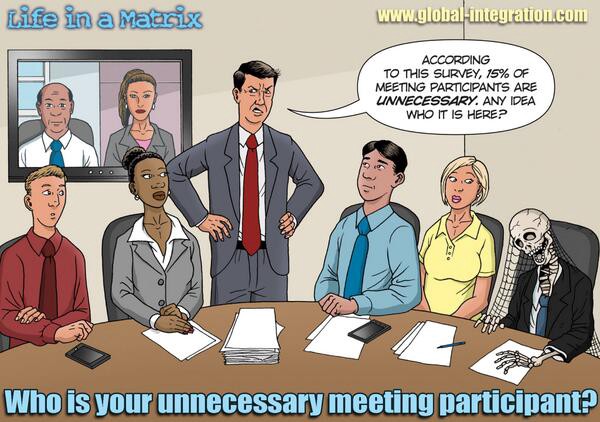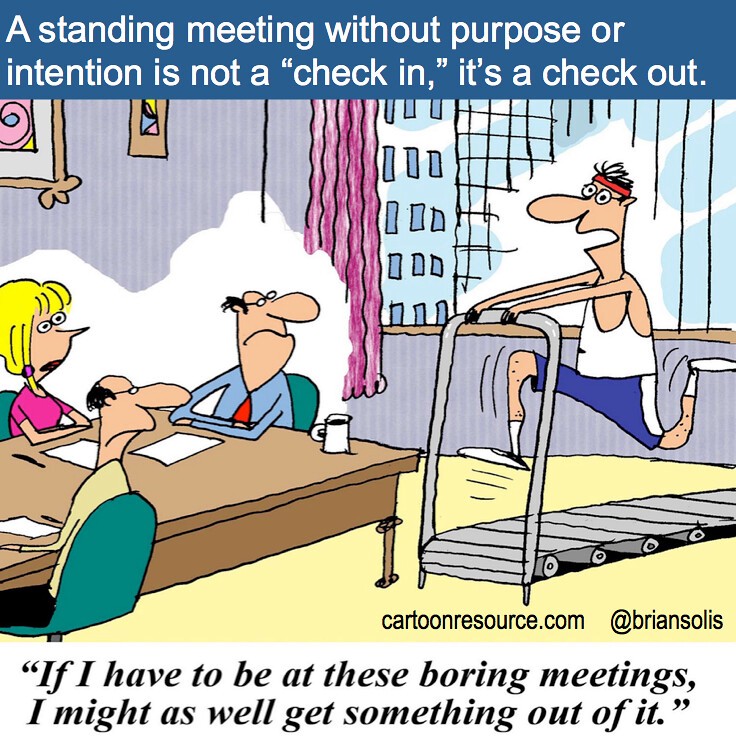The meeting madness and some creative antidotes.

I have taken part in way too many meetings during my professional career that was still going on an hour so later. Some of the reasons for such long meetings usually boiled down to:
- the discussion revolving around things that didn’t need to be raised with everyone present,
- discussing things that weren’t part of the original agenda, repetition of content, etc.
The feelings at the end of such meetings were far from being satisfied. We should not have a meeting as a reason to drag everyone into a room and put everything on hold for the duration of the meeting. Meetings that are called at the last minute or constantly postponed are an indication that the person does not have respect for the attendees.
A meeting is when attendees explain and discuss their viewpoints with each other regarding an issue to reach common ground, an agreement, or understanding. The reasoning is an essential basis which helps us to express ideas. This enables us to have a dialogue, discussion, argument, and debate to reach a common understanding. As attendees of a meeting, when we are presenting our point of view, we should accept that other attendees are reasonable, and have intellect, potential, abilities, and desires. On the contrary, if we believe that other attendees are lacking any of the above capabilities then we should forgo any expectation of having a meaningful meeting. Such a meeting is always biased by the attendee who thinks of others as without reason or intellect.
We should have a clear objective for a meeting (including for regular ones).

-
If you have to communicate(one-way); just send an email with a communique and don’t hold everyone hostage to a meeting where just one person is just talking.
-
If it is a chance to catch up on what everyone is doing — have a better process and product, rather than drag everyone to a meeting.
-
If it is an opportunity to gauge how each individual is doing, where an individual sees himself, and to identify potential problems — Just have proper one-on-ones.
In general, we can think of meetings clustered into the following groups:
- For warning: with a rebuke, there is usually no disagreement between the two parties as they believe in the same ideas and principles; unless the warning is unreasonable and based on wrong pretexts.
- For discussion: there can be a disagreement among those who are involved in the dialogue. This should be carried out respectfully. Constructive disputes and debates are recommended it can lead to success and cooperation.
- For dispute: we should avoid useless dialogue, destructive dispute or argument for it wastes time and effort and leads to hate, bitterness, and hostility.

Duration and flow of a meeting:
IMHO, the meeting should always be finished within 30 minutes or so, the agenda should be pre-shared with all attendees. Impromptu meetings are useless and just one-way communication. If a topic needs more than 30 mins then chunk the agenda into several meetings of 30 mins each. The minutes should be recorded by one of the participants. Minutes of the meeting (a summary of items discussed and action items) should be sent to every stakeholder in an email promptly after the meeting. The meeting should be recorded on the calendar for all the participants.
How to conduct a meeting?
The primary objective of a meeting should be to engage, inspire and achieves results.
-
The meeting should be goal-oriented. If your goal is to solve an issue or add a new feature, then everything discussed at the meeting should (only) reflect this in some way. Multiple issues cutting across multiple experiences should be part of separate meetings.
-
If you have a purpose, you must have a meeting agenda. This is a list of the things you want to cover in the time available and must be shared with stakeholders ahead of the time. Itemizing the agenda allows us to estimate the time required for the meeting and identify the relevant people who should be part of the meeting.
-
A meeting should always start on time and only go for the allotted time. If some items on the agenda require more time than is available, they should be moved to the next meeting or, if urgent, a separate meeting should be held with those immediately involved.
-
The purpose of a meeting should be relevant to those in attendance (and if it isn’t, why are they there then?), and the intent of having the attendance is that you want them to participate in the discussion and be involved in the decision-making. People will become genuinely enthused about your meetings if they are encouraged to participate and can see that something is being achieved.

Mannerism for attendees:
-
Be sincere: we should not speak to display our knowledge or show our eloquence in a matter at hand. Let others speak as well.
-
Lower your voice: speak without raising your voice as it reflects a lack of manners and shows you being emotionally attached to the topic. Shun excessive talk and badmouthing others.
-
Don’t insult: don’t insult, abuse, use obscene words, or denigrate others.
-
Know about the topic: It is also important to study the issue beforehand, to consider the words you will say beforehand. It is very serious not to understand the meaning of words and it is insincere talk without the knowledge (Note: for the same reason it important to pre-share the agenda of the meeting with a summary and purpose).
-
Levels of understanding: an etiquette of a proper dialogue is to address people according to their understanding and knowledge.
-
Choice of vocabulary: use simple wording and terminology, even when discussing certain special fields of knowledge. After all the agenda of the meeting is to make people understand and allow them to extend their cooperation.
-
Don’t interrupt: If a person is talking let him finish; we should not interrupt them.
-
Discuss based on facts and figures: firstly, put forth the obvious/self-evident truths which everyone agrees with. With everyone on the same page, the gaps get bridged allowing the discussion to proceed in a positive direction. On the contrary, if we raise controversial issues at the outset, it can make a meeting restricted and tense with a debate.
-
Avoid: finally, it is very important to avoid useless disputes and arguments because it leads to resentment and hostility.
PS: Errors and omissions are regretted and are my own.